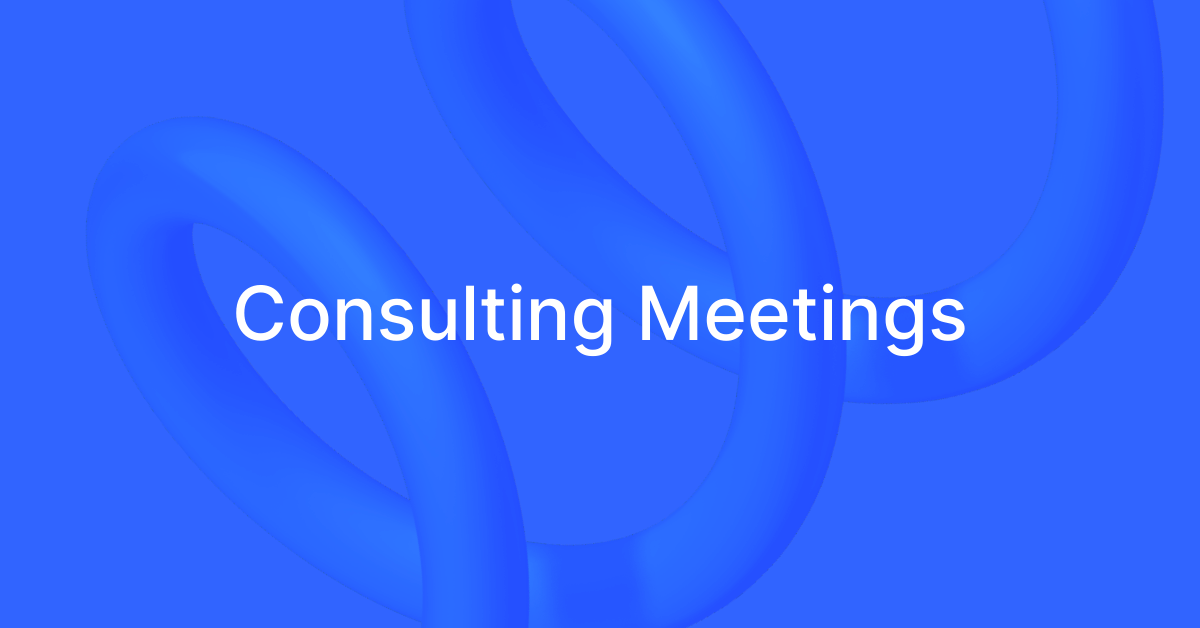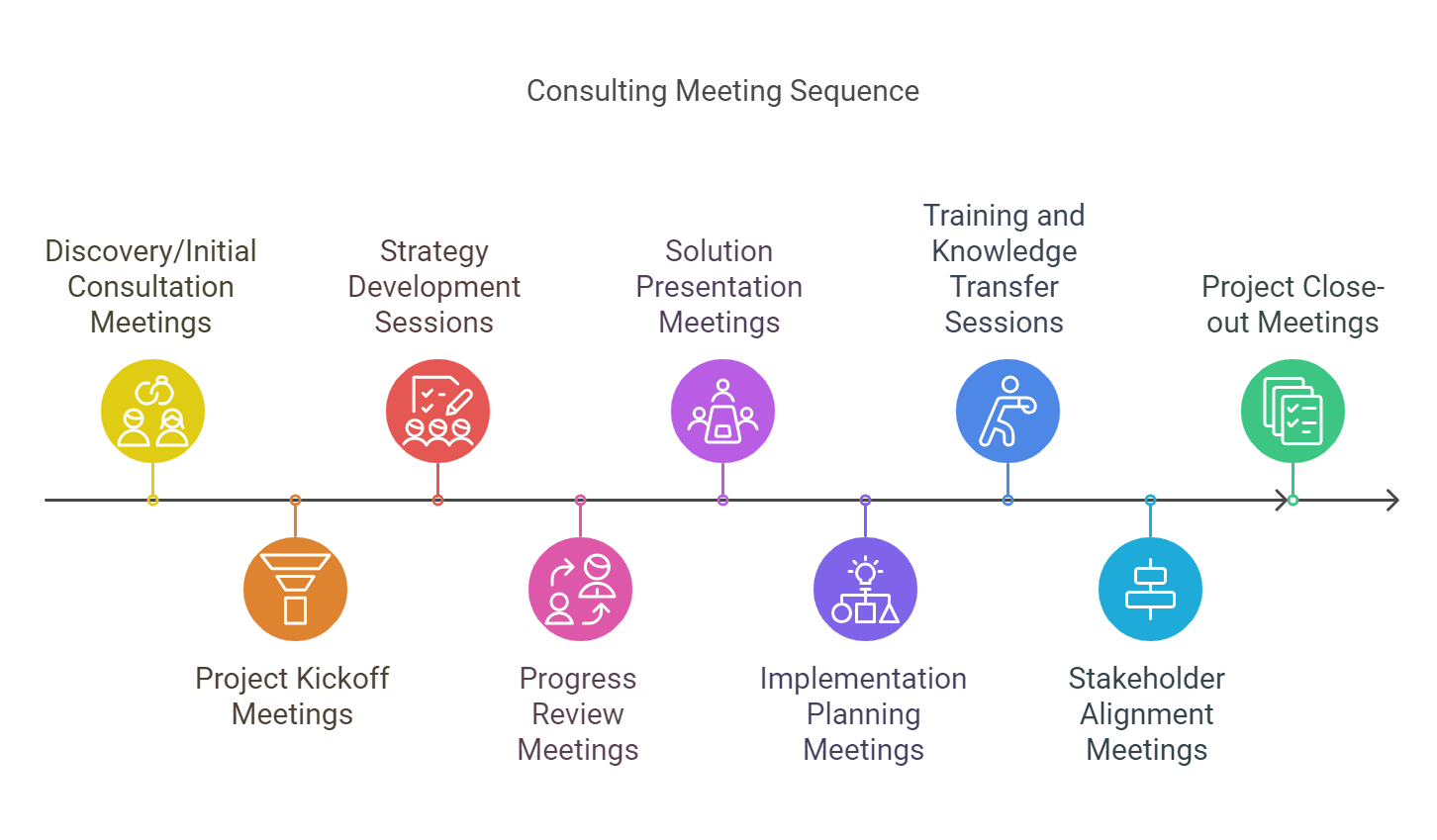
How to Conduct Productive Consulting Meetings [+ Proven Agendas]
Unlock the power of AI — Notta's meeting assistant records, transcribes and summarizes meeting minutes with one click.
If you want clients to start lining up at your door, you must know how to speak to them.
Clients want to hear that you understand their challenges and can solve their key concerns. By structuring your consulting sessions around these two points, you demonstrate value to clients and set yourself apart as a consultant worth investing in.
In this post, I’ll cover the types of consulting meetings, how to structure them effectively and share a ready-to-use meeting agenda template.
Different types of consulting meetings
There are different types of consulting meetings depending on a client's stage of engagement. These meetings include:
Discovery/initial consultation meetings: A discovery meeting is the first meeting you hold with a client to understand the client's objectives, challenges, and goals. By the end of the meeting, you want the client to find you reliable enough to meet their goals.
Project kickoff meetings: A project kickoff meeting happens after a client accepts your proposal and agrees to work with you. In this meeting, you will define the project scope, timelines, deliverables, and expectations and introduce the project team to the client.
Strategy development sessions: This is a strategy workshop where all the stakeholders meet to collaborate and share opinions about an organization's strategic plan. Always start the meeting with the end in mind; ask yourself, "What do we want to achieve by the end of this workshop?"
Progress review meetings: These are regular check-ins you have with a client as a project progresses, often occurring weekly, bi-weekly, or even monthly. You will discuss the project status and challenges and adjust the plan as needed.
Solution presentation meetings: This is a formal meeting where you present your data-driven findings with recommendations after analyzing the client's issues.
Implementation planning meetings: You define the specific steps you plan to take to turn your recommendations into actionable steps and provide suitable mitigation strategies for the risks in the meeting.
Training and knowledge transfer sessions: It’s a workshop where you provide demonstrations or hands-on training to your client's team.
Stakeholder alignment meetings: This meeting helps build a consensus among the stakeholders involved in the project's goals.
Project closeout meetings: A closeout meeting happens at the end of a project. Its purpose is to evaluate whether you have met all of your project's deliverables and objectives.

Preparing for a consulting meeting
Consulting meetings with clients can be stressful and intimidating. Preparing for it places you one step closer to success. Here is how to ensure all participants derive value from your meetings:
1. Pre-qualify all new prospects
Pre-qualifying prospects allow you to assess your likelihood of success long before you begin working with a prospect. Ask your prospect about their challenges, finances, decision-making process, and implementation capabilities.
2. Conduct a pre-meeting research and analysis
Systematically analyze the client's company profile, financial reports, and any content that can reveal their current situation days before your initial consultation meeting.
Tools like Porter's Five Forces can give you an idea of the industry's competitive pressures and potential opportunities. You can also use AI-driven tools to analyze your clients' social media to learn customers' sentiments about their products and services.
With a clear view of all your client's challenges, it becomes easy to tailor your presentation to provide solutions relevant to their situation.
3. Stakeholder preparation
Learn everything you can about the stakeholders attending the meeting. Research their professional backgrounds, influence, and decision-making styles using platforms like LinkedIn and public statements they have made regarding the project or similar initiatives.
Pay close attention to the stakeholders that may resist your proposal and prepare for possible objections in their responses.
4. Develop a clear and concise presentation
Once you’ve gathered client details, create a clear, logical presentation addressing the identified challenges. Use simple language and limit one idea per slide to ensure your audience understands without information overload.
Try to include real-life examples and some storytelling in your presentation.
5. Prepare your technical and logistical setup
Always test your meeting platform 10-15 minutes before your meeting to ensure everything works properly. Consider using a tool that supports video conferencing, recording, transcription, translation, and document sharing.
Arrive early at the venue for in-person meetings and ensure you have working audiovisual equipment and backups if necessary.
6. Define your meeting objectives in an agenda
Set your meeting objectives using the SMART framework before including them in your agenda and allocate a specific amount of time to discuss each point.
Distribute the agenda to your stakeholders before the meeting to give them enough time to prepare feedback and align their expectations.
7. Practice your presentation delivery
Master your agenda to speak confidently in front of the clients. You can rehearse in front of a mirror, record yourself, or present to a colleague.
Don’t forget to prepare multiple solutions for the major points in your agenda to handle potential rejection. If you are interrupted by a question, be flexible enough to answer it and continue your conversation.
Also, rest well before the meeting to stay sharp and handle any curve balls thrown at you during your presentation.
8. Establish your meeting success criteria
You can measure your meeting's success by;
Conducting satisfaction surveys: At the end of a meeting, share an online form where the meeting attendees can provide feedback on the entire experience.
Tracking action items: You can gauge your meeting's impact by monitoring the number of complete action items and the adherence to its agenda without going off-topic.
Measuring your client's engagement rate: Establish a scoring system to quantify your stakeholders' verbal and non-verbal engagement cues.
Notta offers the most integrated AI meeting notes, summaries, and action items so nothing gets missed.
Structuring a consulting meeting for productivity
The success of a meeting lies in how well you structure it. An agenda is the backbone of your meeting; it sequences all the topics you will discuss, driving toward a particular outcome. Giving it a clear structure allows clients to see progress and value in your services.
Proven consulting meeting agenda template
Here is a consulting meeting agenda template you can use to get started:
Consulting Meeting Agenda
Project Name: [Insert Project Name]
Meeting Date: [Date]
Time: [Start Time] - [End Time]
Location: [Physical Location/Virtual Link]
Meeting Lead: [Name]
Attendees
Required:
[Name, Title]
[Name, Title]
Optional:
[Name, Title]
Meeting Purpose
[Clearly state the primary objective of this meeting]
Desired Outcomes
[Specific outcome #1]
[Specific outcome #2]
Agenda Items
1. Welcome and Introduction (5-10 minutes)
Meeting objectives review
Participant introductions (if needed)
Agenda confirmation
2. Core Discussion Topics (20-30 minutes)
[Topic 1]
Key points
Required decisions
Dependencies
[Topic 2]
Key points
Required decisions
Dependencies
3. Action Items and Next Steps (10-15 minutes)
Review of decisions made
Assignment of responsibilities
Timeline confirmation
Next meeting scheduling
Key takeaways summary
Final questions
Confirmation of next steps
Action Items Tracker
| Action Item | Owner | Due Date | Status | Dependencies |
|---|---|---|---|---|
Action Item
Owner
Due Date
Status
Dependencies
Notes Section
[Space for real-time notes and essential discussion points]
Key consulting questions to ask clients
To make your work a lot easier, I have outlined 10 of the best consulting questions to ask a client and get them to open up about their current situation:
What goals do you have for the year?
How different are you from your competitors?
Why are you looking for consulting services?
What are your most pressing challenges so far?
Have you tried any other options? What were the results?
How willing are you to make changes that will affect your daily operations?
Who makes the implementation decision in your organization?
Are there any existing problems that may prevent the execution of this project?
What is the change your organization will most likely not accept?
What is at stake if the execution of this project fails?
Leveraging technology in consulting
Technology can significantly enhance the productivity, efficiency, and quality of interaction in consulting meetings. Notta is one such solution that can help you record, transcribe, summarize, and organize all your meeting notes in one place.

It can identify and list all your action items, making it easy to assign and follow up with all your stakeholders. Notta eliminates manual note-taking, allowing you to focus on presenting solutions to the client. With all your meeting notes and insights in one place, it becomes much easier to follow up on action items.
Apart from Notta, plenty of other AI tools can increase efficiency, giving you a competitive edge in the market. Read more to explore some of the top AI tools for consultants that you can use today.
With Notta, you can easily generate meeting minutes, turning spoken content into written records with 98.86% accuracy.
Following up after the meeting
Meeting follow-ups are as critical as the main agenda. While they don't involve many actions, follow-ups are impactful enough to make clients want to work with you. So, how do you do it?
Within 24 hours after a consulting meeting, send all stakeholders a well-detailed meeting summary that details:
All the agreed-upon decisions from the meeting.
The action items (should include the deadline date and assignee).
The next steps.
The upcoming milestones.
Common pitfalls to avoid in consulting meetings
It's easy to fall victim to certain habits that can make your consulting meetings unproductive. Here are three pitfalls to avoid and some possible mitigation strategies:
Poor communication
Poor communication can occur when you fail to understand a client's needs and expectations. You can solve this by listening and understanding your client's challenges before recommending solutions.
You should also record all meetings and regularly update your stakeholders on the project's progress.
Having too many decision-makers
Too many decision-makers in a consulting meeting can lead to confusion and a slow decision-making process. Before you start working with a client, map out roles and responsibilities for every stakeholder.
Then, establish clear decision-making criteria to increase your project's efficiency.
Basing your argument on theory
Many consultants lose clients by suggesting vague theoretical concepts that have yet to show results. This can lead to a client disconnect since most prospects seek practical solutions to their immediate problems.
While theoretical concepts can provide extensive insights, base your client recommendations on measurable, research-based data.
Conclusion
What type of consultant do you want to be? One that drives results or one who is ignorant about the simple things affecting client success? The secret often lies in effective meeting preparation and clear agendas with actionable outcomes.
Clients don’t just pay for your time—they pay for results. Focus on delivering value in every meeting, and clients will see you as a worthwhile investment.